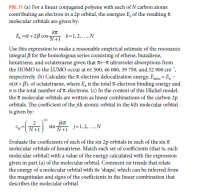Question

Transcribed Image Text:P9E.11 (a) For a linear conjugated polyene with each of N carbon atoms
contributing an electron in a 2p orbital, the energies E, of the resulting A
molecular orbitals are given by:
E, =a+2B cos-
N+1
k=1, 2,.,N
Use this expression to make a reasonable empirical estimate of the resonance
integral B for the homologous series consisting of ethene, butadiene,
hexatriene, and octatetraene given that t-n ultraviolet absorptions from
the HOMO to the LUMO occur at 61 500, 46 080, 39 750, and 32 900 cm",
respectively. (b) Calculate the T-electron delocalization energy, Egdo:= E, -
n(a+ B), of octatetraene, where E, is the total T-electron binding energy and
n is the total number of T-electrons. (c) In the context of this Hückel model,
the molecular orbitals are written as linear combinations of the carbon 2p
orbitals. The coefficient of the jth atomic orbital in the kth molecular orbital
is given by:
cN sin j=1,2.N
jkn
j=1, 2,.,N
Evaluate the coefficients of each of the six 2p orbitals in each of the six T
molecular orbitals of hexatriene. Match each set of coefficients (that is, each
molecular orbital) with a value of the energy calculated with the expression
given in part (a) of the molecular orbital. Comment on trends that relate
the energy of a molecular orbital with its shape, which can be inferred from
the magnitudes and signs of the coefficients in the linear combination that
describes the molecular orbital.
Expert Solution
This question has been solved!
Explore an expertly crafted, step-by-step solution for a thorough understanding of key concepts.
This is a popular solution
Trending nowThis is a popular solution!
Step by stepSolved in 2 steps

Knowledge Booster
Similar questions
- Suppose the distance between the two atoms is equal to the equilibrium distance found in part A. What minimum energy must be added to the molecule to dissociate it-that is, to separate the two atoms to an infinite distance apart? This is called the dissociation energy of the molecule. For the molecule CO, the equilibrium distance between the carbon and oxygen atoms is 1.13×10−10m and the dissociation energy is 1.54×10−18J per molecule. Find the value of the constant a. Find the value of the constant b.arrow_forwardWhat are the most common elemental dopants in the solar cell industry to create n+ -type and p-type regions, respectively? Please schematically illustrate their doping mechanisms based on atomic lattices.arrow_forwardBelow is the LCAO for the sp3 hybrid orbital. What is the value for the c²? (The answer mus be a number, not a fraction) Ya = C($25 +02p₂ +$2p, + $2p:) 2Pxarrow_forward
arrow_back_ios
arrow_forward_ios